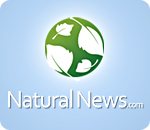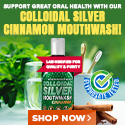
Understand the Role of Therapy: A New Old Perspective
Tuesday, February 24, 2009 by: Dr. Samuel Mielcarski
Tags: psychology, health news, Natural News
- If FLUORIDE is SO GOOD for us, WHY does the packaging look like THIS?
- The Health Ranger releases “Vaccine Zombie” song and music video, using AI-animated zombies for the music video
- Federal Judge blocked Trump's attempt to terminate wasteful government credit cards, so DOGE and ELON MUSK set spending limit to ONE DOLLAR - problem solved
- Trump administration strips security clearances from “SPIES WHO LIED”, blocking Biden and his cronies from intelligence briefings
- Israeli soldiers accused of even more torture and abuse in the West Bank
- Top streamer warns: Reddit cracking down on violent rhetoric could pave the way for INTERNET REAL ID, ending online anonymity
- Coriander seeds: Ancient medicine backed by modern science
- Mike Adams releases music poetry sensation: A Child of God
- Center for Countering Digital Hate launches BLACK OPS campaign against RFK Jr.
- Former horse rancher and 6,000 other plaintiffs are suing Syngenta after paraquat exposure led to Parkinson's Disease
- Trump confirms funding cuts to South Africa, offers CITIZENSHIP to Afrikaner farmers whose lands were seized
- Mike Adams releases new song and music video: Nothing More Disgusting Than a Globalist
- House Intelligence Committee calls for the ARREST and PROSECUTION of Dr. Anthony Fauci
- Russia warns citizens against traveling to the United States, Canada and the European Union
- Michigan sheriff announces criminal investigation into 2020 election crimes, Dominion Voting Systems
- California's social media censorship law struck down: A victory for free speech or a threat to online safety?
- Trump administration takes on global censorship: A new frontier for free speech advocacy
- Economic treason
- California's social media censorship law struck down: A victory for free speech or a threat to online safety?
- The Health Ranger releases “Vaccine Zombie” song and music video, using AI-animated zombies for the music video
- Florida takes a stand: DeSantis proposes permanent ban on mRNA vaccine mandates
- Former horse rancher and 6,000 other plaintiffs are suing Syngenta after paraquat exposure led to Parkinson's Disease
- Modern science uncovers brain-boosting power of ancient spice coriander and its key compound linalool
- EPA advisor admits the agency is funneling billions to climate groups ahead of Trump’s return to White House
- Michigan sheriff announces criminal investigation into 2020 election crimes, Dominion Voting Systems
- Congratulations to the FULLY UNVACCINATED as you resisted the COVID-19 PROPAGANDA MACHINE fueled by over $100 BILLION
- Peter Rost exposes Big Pharma corruption in his book “The Whistleblower: Confessions of a Healthcare Hitman”
- House Intelligence Committee calls for the ARREST and PROSECUTION of Dr. Anthony Fauci
- Ballot drop boxes set ablaze in Oregon and Washington, prompting security concerns ahead of election
- The pandemic as a tool for INDOCTRINATION: Understanding “The Indoctrinated Brain” by Dr. Michael Nehls
- Migrants are taking advantage of recent hurricanes to scam residents and loot their homes
- Sermon 30: How Jesus reveals Caesar’s FAKE CURRENCY and FALSE AUTHORITY
- Israeli soldiers accused of even more torture and abuse in the West Bank
- Arizona officials claim Maricopa County needs 10-13 days to tabulate results of the election
- Federal judge backs Trump's mass firings, clearing path for government downsizing
- Jena Griswold “breaks” 2024 election in Colorado: Results will be 100% non-certifiable, warns Patrick Byrne
- EPA advisor admits the agency is funneling billions to climate groups ahead of Trump’s return to White House
- RFK Jr. clears key hurdle: Sen. Susan Collins backs controversial HHS nominee, signaling a new era for health policy
- Global leaders unite to clamp down on “misinformation” with UN-backed Cascais Declaration
- Congratulations to the FULLY UNVACCINATED as you resisted the COVID-19 PROPAGANDA MACHINE fueled by over $100 BILLION
- DIRTY VACCINES: Dr. Anthony "Fraudulent" Fauci, King of the Covid scamdemic, admits "We don't do placebo trials on vaccines"
- The Health Ranger releases “Vaccine Zombie” song and music video, using AI-animated zombies for the music video
- Democrats cry as “liberal supply chains” are wiped out and their favorite multi-billion dollar money machine is shut down
- Fake "CLIMATE CHANGE" will continue to devastate any regions the globalists and ruling elite want to purchase at a discounted price
- Mint: The ancient herb that refreshes, soothes and heals
- PBS shutters DEI office in wake of Trump’s executive order
- South Korean banks halt silver bar sales amid global and domestic uncertainty
- “Cancer Gag Act” threatens farmers’ rights and public health: A dangerous push for corporate immunity
- James V. DeLong’s book “Out of Bounds, Out of Control” provides a gripping tale of how the EPA operates outside the rule of law
- Trump administration takes on global censorship: A new frontier for free speech advocacy
- Trump's impressive political comeback against all odds makes headlines around the world
- The pandemic as a tool for INDOCTRINATION: Understanding “The Indoctrinated Brain” by Dr. Michael Nehls
- Deep State Power Grab? Corporate Transparency Act threatens nonprofits and small businesses – Andy Schlafly discusses potential impacts with Mike Adams
- Kyiv plans to recruit 160K soldiers amid mounting cases of DESERTION in Ukrainian military
- Red Cross issues warning to stop blood plasma donations from vaccinated people
- Scientists confirm: GENIUS brain function can be spontaneously unleashed in humans without any apparent cause
- HYSSOP: What research reveals about the health benefits of this ancient holy herb
- EPA advisor admits the agency is funneling billions to climate groups ahead of Trump’s return to White House
- Two containers with completed ballots fall out of truck in Florida
- Fully vaccinated about to see “tsunami” of illness and death, warns virologist
- Today I asked our AI language model “Neo” about which phytonutrients or phytochemicals can block the spike protein related to SARS-CoV-2 … Here is what it answered…
- Global leaders unite to clamp down on “misinformation” with UN-backed Cascais Declaration
- DATA: England’s vaccinated population had close to one million deaths in 23 months; unvaccinated population had less than 61,000 deaths over the same period
- BREAKING: 2025 NDAA authorizes mandatory military draft of WOMEN across America… as Pentagon pursues global NUCLEAR war with both Russia and China at the same time
- ENGINEERED FAMINE: Oregon starts SHUTTING DOWN small farms “to protect the people”
- Michael Yon warns of a ZIONIST TAKEOVER in Trump’s second administration
- Ozempic and Wegovy weight loss drugs are injectable LIZARD VENOM PEPTIDES that may unleash a devastating wave of organ failure… side effects align with symptoms of SNAKE BITES
- NASA admits that climate change occurs because of changes in Earth’s solar orbit, and NOT because of SUVs and fossil fuels
- These 13 countries just signed an agreement to engineer a global FAMINE by destroying food supply
- BOMBSHELL: DNA testing kits are a SCAM to develop ethnic-specific bioweapons
- Careless Whisper: AI-powered transcription tool being used by hospitals found to invent chunks of text no one ever said
- BBC staffers accuse media outlet’s executives of instituting bias in Gaza coverage, claiming favorable treatment of Israel
Let`s Define Therapy
The word "therapeutic" derives from the Greek and Latin words "therapeutikos," "therapeuein," "theraps," and "therapia," which mean literally, attend to - in the sense of observing and attending to an individual`s needs or requirements - and to wait upon - in the sense of allowing a process of illness or injury to run its course naturally. It`s interesting to note the original intent of the term "medicine" or "medicina": the art of healing (it had nothing to do with an artificial drugging system).
The contemporary meaning of therapeutics refers to the treatment or curing of disease or disorders using various remedial agents. These remedies may be applied in the following various manners: frequently or occasionally, in short durations or long durations, aggressively or conservatively, pleasantly or painfully, voluntarily or involuntarily, and in isolation or in combinations. Thus, the use of some sort of healing cure that is imposed on or dispensed to, the body, mind, and spirit appears to underlie most modern-day therapies.
Therapy from Within
The body is instinctively programmed to heal itself in an optimal manner, if and when its needs are properly met or attended to. This means that true therapy comes from within. It can`t be replaced by applying artificial treatment methodologies from the outside, which just usually interfere with the natural healing process. Therapies need not be forced onto the body, mind, and spirit to produce beneficial effects, especially at the expense of depleting the body`s own self-healing and therapeutic powers, which is the true beneficial force at work in most, if not all, cases.
Alteration of Symptoms vs. Removal of Cause(s)
Any therapy that claims to be beneficial in the healing process should always be inspected properly to determine whether or not this therapy assists the body`s own natural healing mechanisms, or detracts from them. For example, when certain substances (either artificial or "all-natural") are taken into the body that suppress and/or alter the innate healing process, interference as opposed to assistance will be occurring. Another example of interference found commonly in many rehabilitation programs is the application of a cold modality (ice pack) used to rid the body of inflammation - a natural process the body uses to heal itself.
It`s important to realize that the body will create certain conditions during the healing process. These healing conditions are accompanied often by healing symptoms, including but not limited to: pain, inflammation, swelling, fever, coughing, sneezing, sweating, mucous discharge, skin outbreaks, flu-like symptoms, lumps, bumps, changes in heart and breathing rate, and extreme voiding such as diarrhea or vomiting. Therefore, caution should be given to any therapeutic intervention that suppresses or alters healing symptoms, rather than promoting actual healing. Getting temporary symptom relief at the expense of disrupting the body`s self-healing processes can be counterproductive in the long run. As the old saying goes: "It`s not wise to fool with Mother Nature!"
The Illusion of Cure
Many therapies can actually deter the healing process, as opposed to cure the body. Unfortunately, this happens at the expense of decreasing vital self-healing energy. In the short run, this negative effect of many therapies will produce the illusion of cure. This phenomenon comes about when the body is asked to deal with an unnecessary therapeutic intervention, which in many cases may be more appropriately termed a "therapeutic interference." In other words, when the body is required to stop attending to the act of healing itself so that it can deal with an unnecessary remedial intervention being applied, a symptom-relieving effect is often produced - giving rise to the illusion that a cure has taken place when it really hasn`t.
This healing scenario is analogous to forcing an injured/ill horse to perform better by whipping it, instead of giving it proper rest and care. However, under such conditions of artificial stimulation or irritation, the horse`s performance will eventually suffer, especially if this whipping practice is ongoing. The human body will respond in a similar manner. Its performance will suffer as well, with delayed healing or a decrease in optimal health being the result.
Healing Can Be a Pain
Pain is one of the most common symptoms that make an individual seek out therapeutic interventions. So, is there anything wrong with wanting relief from pain? Of course not. Seeking relief from pain is a natural human instinct. However, it`s important to understand that pain is sometimes part of the natural healing process. Once one truly embraces this, he or she may then learn to benefit from these painful experiences, rather than always seeking to avoid them. This is how the "No pain, no gain" philosophy should be applied. In other words: One should learn from the pain, so that there is gain - an acquisition of more wisdom about how to properly care for the body.
Pain is one of the mechanisms the body uses to protect and heal itself, especially its vital parts. Pain is not the enemy, but rather an ally. Pain is like the warning light on a dash board, so it`s wise to pay attention to it. (P.A.I.N. = Pay Attention Intelligently Now). Figuring out why the warning light is going off (the cause) is important, so that the problem can be corrected properly. Just pulling out the fuse that controls the warning light does not correct the problem - unless of course, the warning light itself is the real problem.
A choice will always need to be made regarding how to deal with the pain of healing. For the person whose objectives are vibrant health, restoration of optimal function, and maintenance of a high quality of life, the choice should be clear. True therapies will address pain, but not at the expense of jeopardizing overall health and well-being.
Making Sense of Symptoms
Whenever addressing an acute or chronic health matter, it`s important to always determine the cause(s) and/or type(s) of symptoms so that treatment can be administered properly. Reactive symptoms (a.k.a. healing symptoms) that sometimes occur during the healing process shouldn`t be confused with those that are destructive in nature. Destructive symptoms result from damage to the body itself, such as the effect heavy metals can have on the body`s tissues. Both types of symptoms are noteworthy, as reactive symptoms signal a return to health, whereas destructive symptoms signal a progression away from health (toward disease).
Other types of symptoms to be aware of are: symptoms of deficiency, and symptoms of degeneration. An example of the first would be the body malfunctioning due to a nutrient deficiency (food, water, air, sun, rest, activity). An example of the latter would be the body functioning incorrectly due to destruction in joint, muscle, nerve, vessel, tissue, or organ structure. Like symptoms of destruction, both of these types of symptoms are indicative of disease, or a movement away from good health. As mentioned before, a common mistake people make when trying to heal their bodies is suppressing healing symptoms - misinterpreting them as something needing to be cured, as opposed to being the cure. However, misinterpreting destructive symptoms can occur as well [for example: thinking every symptom is just the body "detoxifying itself" (such as having pain and loose teeth), when it`s really the body`s cry for help].
Determining which types of symptoms are present is a matter of tuning in carefully to the body. One`s instincts can help guide him correctly in this endeavor. The key is to learn to read the body correctly. This will take some practice, especially when one has lived way out of touch with his instincts for a long time. Therefore, seeking out proper guidance or help from another individual when needed is always permissible.
Therapeutic Systems
Allopathy treats illness and injury through introducing substances that counteract, or work against symptoms. Homeopathy treats disease through introducing substances that produce like symptoms, according to the homeopathic dictum that like cures like. Naturopathy is the practice of using natural substances and remedies to help bring the body back into a balanced state of health. There are many other therapeutic interventions and systems of healing that aim to help cure the body as well. Again, consideration as to whether or not these interventions are actually helping or hindering the body`s own magnificent self-healing abilities is prudent.
Therapies that are applied in a palliative manner fail to get at the underlying causes of a problem. Consequently, this can lead to dependency on the pursuit of finding more therapies to address a poor health condition. This search for the "holy-grail-of-all-therapies" can lead to expensive addictions and ineffective solutions.
The body comes equipped with a self-healing system that is encoded at the cellular level from the time of birth. When the body is allowed to operate without impediment, healing will occur in an optimal manner. There are certain times (emergency situations) that may warrant special therapeutic interventions. However, even in these cases, when these interventions are implemented correctly, they act to assist, rather than interfere with, the body`s own self-healing powers.
Therapeutic Perspectives
Many ancient and primitive therapeutic systems were based on the following underlying concept: Injuries/illnesses are hostile processes that need to be attacked with treatment in order to remove or eliminate them from the body successfully. Many modern therapeutic approaches don`t appear to be much different -- only the technology has changed. The body`s responses to an injury/illness are ultimately beneficial. They are governed by an instinctive vital self-healing power. This innate power is always aimed at defending and protecting the body to its fullest capacity, and in the safest and fastest manner possible. The body doesn`t need to be attacked. This approach has failed throughout time, and will continue to do so. The body needs to be honored and cared for properly instead. Attempting to trick the body, by performing the act of healing better than Mother Nature can (as if that were possible), is always a mistake. If one does find the need to attack the body, then attacking it with a healthy diet and lifestyle appears to be the most logical and safest approach.
Sources:
1. Baker, A., Awakening Our Self Healing Body: A Solution to the Health Care Crisis, Self Health Care
Systems, Los Angeles, CA, 1994
2. Lee, A., Your Body: Designed to Be Self-healing, Living Nutrition Magazine, Volume 19, p.21-22, 2007
3. Shelton, H., Human Life It's Philosophy and Laws: An Exposition of the Principles and Practices of
Orthopathy, Mokelumne Hill Press, Dec. 1979
4. Mielcarski, S., Revolutionary Rehab Manual, www.revolutionaryrehab.com, Body Dynamic Publishing,
2007-2009
5. Ozer, MN, Payton, OD, and Nelson, CE: Treatment Planning for Rehabilitation: A Patient-Centered
Approach, McGraw Hill, New York, 2000
6. Weil, A., Spontaneous Healing: How to Discover and Enhance Your Body`s Natural Ability to Maintain
and Heal Itself, Ballantine Books, 1996
About the author
Dr. SAM (Samuel Arthur Mielcarski), DPT, is an expert in the field of rehabilitation. He is currently licensed as a physical therapist in Georgia and Florida. He has over 13 years of clinical rehabilitation and health-coaching experience, combined with additional training, education, and practical experience in integrative bodywork, nutrition, natural hygiene, exercise/fitness, mind-body integration, performance enhancement, and personal training. He is the author of the recently released: "Revolutionary Rehab Manual: A Common Sense Approach to Health and Healing." Details can be found at: RevolutionaryRehab.com. He can be contacted via email at DrSamPT@gmail.com or through his main website: www.DrSamPT.com.Psychology at FETCH.news
Get independent news alerts on natural cures, food lab tests, cannabis medicine, science, robotics, drones, privacy and more.
Take Action: Support Natural News by linking to this article from your website
Permalink to this article:
Embed article link: (copy HTML code below):
Reprinting this article:
Non-commercial use OK, cite NaturalNews.com with clickable link.
Follow Natural News on Facebook, Twitter, Google Plus, and Pinterest
Science News & Studies
Medicine News and Information
Food News & Studies
Health News & Studies
Herbs News & Information
Pollution News & Studies
Cancer News & Studies
Climate News & Studies
Survival News & Information
Gear News & Information
News covering technology, stocks, hackers, and more



"Big Tech and mainstream media are constantly trying to silence the independent voices that dare to bring you the truth about toxic food ingredients, dangerous medications and the failed, fraudulent science of the profit-driven medical establishment.
Email is one of the best ways to make sure you stay informed, without the censorship of the tech giants (Google, Apple, Facebook, Twitter, YouTube, etc.). Stay informed and you'll even likely learn information that may help save your own life."
–The Health Ranger, Mike Adams












































